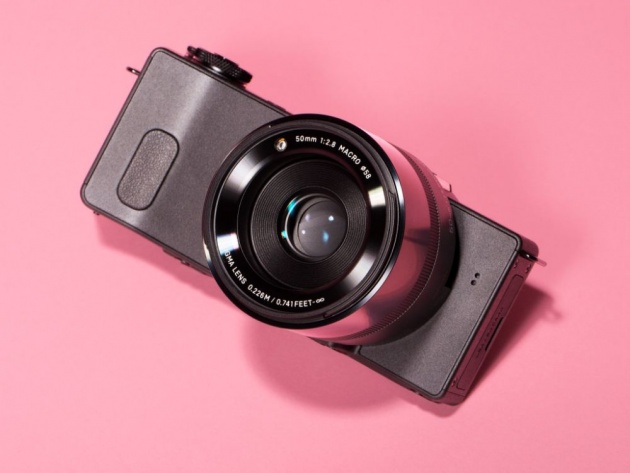
The Sigma DP3 Quattro doesn’t look like other cameras, and the Sigma DP3 Quattro doesn’t act like other cameras. If you look past its unique sensor and body—which would require ignoring two of its biggest points of distinction—it’s a good camera for portraits and macro photography: a fixed-lens, fixed focal-length shooter with a 75mm/F2.8 lens. If the environment is just right, it takes stunning pictures that trump most cameras at its price. (Some sample images are here.)
However, there are serious usability issues to consider with the DP3. It’s slow to autofocus, it’s scared of the dark, and it suffers from a bit of an identity crisis. While it captures wonderful pictures, it’s a niche camera—even more so than its oddball looks would indicate.
The sensor is the big reason to buy this camera—and the big reason not to. It’s an APS-C size sensor, which is the same size found in most consumer DSLRs and mirrorless cameras. However, this one gathers light in an entirely different way.
Rather than capture red, green, and blue light on adjacent photosites like the ubiquitous Bayer-filter sensor, this “Foveon” design stacks the color filters like a Dagwood sandwich. At every pixel, light passes through a blue filter, a green filter, then a red filter. That means at every pixel, every color is captured. The anti-aliasing and interpolation needed for Bayer-filter sensors—factors that negatively impact sharpness and color accuracy—aren’t in play here. Sigma claims those enhancements add up to the equivalent of a 39-megapixel Bayer sensor—there’s actually a 3:2 JPEG mode in the camera that captures 39-megapixel images—but in RAW mode and most JPEG modes there, is a maximum resolution of 19.6 megapixels.
 Click to Open Overlay Gallery
Click to Open Overlay Gallery
From a practical standpoint, that should translate to sharper images and more-accurate colors. For the most part, that’s true. As long as you’re shooting in daylight or in well-lit environments, the DP3 Quattro cranks out images with incredible detail and color fidelity.
But there’s a big drawback to that Foveon sensor: Less light gets through to the sensor after traveling through that triple-decker filter stack, and the camera is a disappointing low-light performer for its $1,000 price. ISO settings go up to 6400, but the top three stops aren’t so great. Once you get to ISO 800, that stellar image quality takes a hit. It is among the best-performing cameras out there in broad daylight, but its image quality in the dark and its 75mm fixed focal length add up to a camera that isn’t very versatile. It also doesn’t shoot video.
Autofocus performance is frustrating. Across the industry, autofocus speeds have improved dramatically in recent years—they’re regularly measured in speeds less than a tenth of a second nowadays—but the DP3 Quattro often struggles to find its subject. Again, this is especially true in low light, where the camera’s contrast-detection AF system often searches in and out for seconds and regularly doesn’t find what it’s looking for. Darkness is challenging for any camera’s AF system, but the DP3’s is particularly pokey.
Luckily, you can fine-tune the focus manually by half-pressing the shutter button and twisting the lens barrel. However, unlike rival cameras, there’s no focus-peaking feature to help you get everything tack-sharp. The magnification view on the camera’s 3-inch LCD helps a bit, but there’s no eye-level viewfinder to help you see everything when it’s sunny out. And the camera’s nine-point AF system, which you can control with a little D-pad on the back, is bare-bones.
There’s a bit of an identity crisis going on with this camera’s control scheme. On one hand, it’s refreshingly simple and uncluttered. There’s a mode button, the shutter button, and two scroll wheels up top to adjust exposure controls and onscreen menus. On the back, there’s a “QS” button to access deeper settings, an auto-exposure lock button, menu and playback buttons, and the focus D-pad.
 Click to Open Overlay Gallery
Click to Open Overlay GalleryThat lack of packed-in buttons and dials makes the camera unintimidating to pick up and shoot with, but that’s sort of deceiving. Given its strong suits and manual-control options, this isn’t really a camera for novices. There are three custom-setting options in the “Mode” menu, along with full-manual, aperture- and shutter-priority, and program Auto. It’s an advanced camera disguised as an oversized point-and-shoot, and many potential buyers would want quicker access to things like exposure compensation, ISO, RAW, and continuous-shooting modes without any menu-diving.
Frustratingly, there’s plenty of room for more buttons thanks to the camera’s size and unique shape. The body style, which is as sturdy-feeling as it is odd-looking, is the first thing you notice. While shooting in New York City, someone asked me if it was some sort of fancy smartphone-camera accessory: The wide, slim profile certainly looks like it was built to house a phone. It looks strange, but it works well ergonomically. The handgrip is very pronounced, delivering a more-secure handfeel than most, and it’s well-balanced due to the weight of the substantial lens.
With a rating of just 200 shots per charge, battery life is on the very low side for a camera of this caliber and price. But there’s a bonus: You get two batteries in the box, and you charge them outside the camera. That means you can always have a fully charged spare ready to go if you plan ahead.
The Sigma DP3 Quattro certainly isn’t a jack-of-all-trades, but it’s a master of at least one: portraits in good lighting. The image quality is hard to top in that scenario. But you must consider the tradeoffs. Autofocus, low-light image quality, and high-ISO performance are lackluster, and its target audience will expect more physical controls, better manual-focus tools, and interchangeable lenses. It’s a tough sell given the drawbacks, but the image quality may be worth the gamble.



